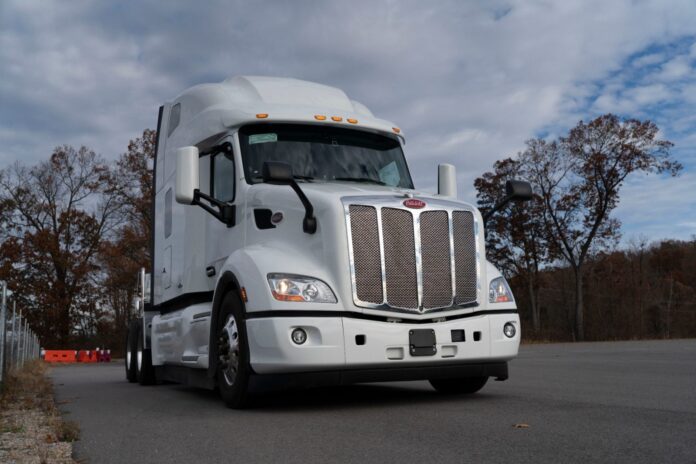A new four-year study, led by the Virginia Tech Transportation Institute (VTTI) in partnership with a 16-member team, seeks to provide the trucking industry, regulators, and the general public with practical guidelines for safely integrating automated driving systems into current fleets. The research is funded by a $7.5 million grant from the U.S. Department of Transportation.
“This research will accelerate the analysis of automated systems with the trucking industry,” said Virginia Secretary of Transportation Shannon Valentine. “This will improve safety and maximize the economic investments in freight and commerce.
The federal award is one of two that VTTI received notification of in September through the Automated Driving System Demonstration Grants program. Additional support is provided by the Virginia Department of Transportation and cost share from the project team members.
“The introduction of automation into heavy trucks is expected to have a profound effect. However, it is still unclear how these vehicles should best be integrated into fleet operations with conventional trucks,” said Richard Hanowski, director of VTTI’s Center for Truck and Bus Safety. “This generous grant from the Department of Transportation will enable VTTI and our partners to produce critical data to help guide rulemaking and fleet operations.”
“VTTI has assembled a world-class team that includes automated driving system technology developers, trucking fleets, six state departments of transportation, and other supporting organizations, to tackle this topic,” noted Martin Walker, who will serve as the principal investigator for the project.
The operational plan, formally called a fleet concept of operations, will include best practices for technology deployment, driver training, installation and maintenance, inspection procedures, insurance, roadway readiness, data, and cybersecurity for automated driving systems.
“We are excited to be part of this industry-leading collaboration to help identify and solve some of the challenges of deploying automated commercial trucks within a fleet setting,” said Sherry Sanger, executive vice president of marketing at Penske Transportation Solutions. “As the lead maintenance and vehicle supplier to this program, our truck leasing and logistics business units will help spec the vehicles, define best practices for the installation and maintenance of automated driving systems, manage the overall maintenance of test vehicles, and road test the vehicles in a delivery setting.”
The team will work with safety technology developer Pronto to demonstrate the safe and gradual integration of various levels of advanced automation technology into fleet operations on public U.S. roadways. Pronto’s technology will be retrofitted into existing heavy vehicles to support this research. Common driving situations, such as queuing in ports, drayage operations, and exit-to-exit scenarios, will be tested using an evolutionary phased approach, resulting in a critical review of the extent to which the theoretical safety benefits of automation can be captured in practical, real-life trucking operations. Notably, one demonstration will involve a highly automated truck driving across the country in the first uninterrupted cross-country journey of its kind.
“We look forward to working closely with VTTI and the other partners to develop a practical framework for bringing advanced safety technologies to market,” said Robbie Miller, Pronto’s CEO. “We are especially excited by the breadth and expertise of the project’s team, which spans all relevant aspects of trucking. Automation will not be introduced in a vacuum, which means it is incumbent on technology developers like Pronto to ensure that the solutions we build can easily and safely be integrated into today’s trucking ecosystem to provide maximum value. Rather than building systems to replace drivers or attempting to ‘disrupt’ and compete with established trucking fleets and manufacturers, we think all stakeholders working together will result in new and meaningful solutions to bring more safety and comfort to the truck driving experience.”
A primary objective of the study is to show how automated driving systems can be implemented in a safe, reliable, repeatable, and commercially viable manner. As such, the team intends to demonstrate a realistic, “mixed-fleet” approach and generate data of practical importance to the trucking industry, regulators, and the public at large.
“Hub Group is committed to advancing technologies that make our roads safer, benefit our customers and reduce our impact on the environment,” said Phil Yeager, president and COO of Hub Group, a $4 billion supply chain solutions provider and one of only two trucking companies on the VTTI project team. “Autonomous Driving Systems represent great potential, and we’re thrilled to work alongside Pronto and the rest of the team on making safe, practical integration of autonomy a reality for our fleet and our nearly 5,000 drivers in the foreseeable future.”
“The Coalition looks forward to bringing the regional, state DOT practitioner and freight perspective into the work of testing the operation of mixed motor carrier fleets across state boundaries. For 25 years we have addressed how technology changes the movement of passengers and freight and this project is critical to assessing the feasibility of CV and AV technology in the near term,” said Patricia Hendren, executive director of the I-95 Corridor Coalition.
Roadshows are being planned to give truck drivers, fleet managers, government officials, insurance reps, inspection agencies, and the general public the opportunity to learn firsthand about commercial vehicle Automated Driving System (ADS) technologies. Attendees will be able to meet technology developers and ADS integrators, as well as participate in hands-on demonstrations on closed tracks. More information will be announced as it becomes available.

